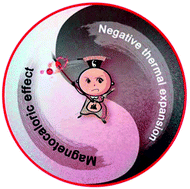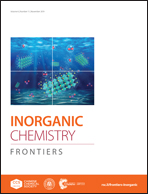A case of multifunctional intermetallic compounds: negative thermal expansion coupling with magnetocaloric effect in (Gd,Ho)(Co,Fe)2†
Abstract
Metallically functional materials with unique negative thermal expansion (NTE) or magnetocaloric effect (MCE) are promising in applications. Herein, we report the coexistence and coupling of NTE and MCE in (Gd,Ho)(Co,Fe)2 intermetallic compounds. Upon the incorporation of Gd and Fe, the coefficient of thermal expansion changed from strong negative in HoCo2 (HC, αV = −3.26 × 10−4 K−1) to moderate negative in HoCo1.92Fe0.08 (HCF, αV = −6.66 × 10−5 K−1) and to unusual zero in Gd0.3Ho0.7Co1.92Fe0.08 (GHCF, αV = −0.91 × 10−6 K−1); moreover, the corresponding magnetic entropy change −ΔSM reduced from the large value of 12.72 J kg−1 K−1 in HC to the small value of 2.98 J kg−1 K−1 in HCF and to the negligible value of 1.23 J kg−1 K−1 in GHCF under a field change of 2 T. Utilizing the temperature-dependent neutron powder diffraction and via magnetic measurements, we found that both NTE and MCE were governed by the same physical quantity, i.e., the reducing rate of magnetic moments at the rare earthsite upon heating, whereas MCE was further reinforced through an intermediate contribution from magnetovolume effect that gave rise to NTE. Thus, the present insight could be helpful for the future design of new multifunctional materials.



 Please wait while we load your content...
Please wait while we load your content...